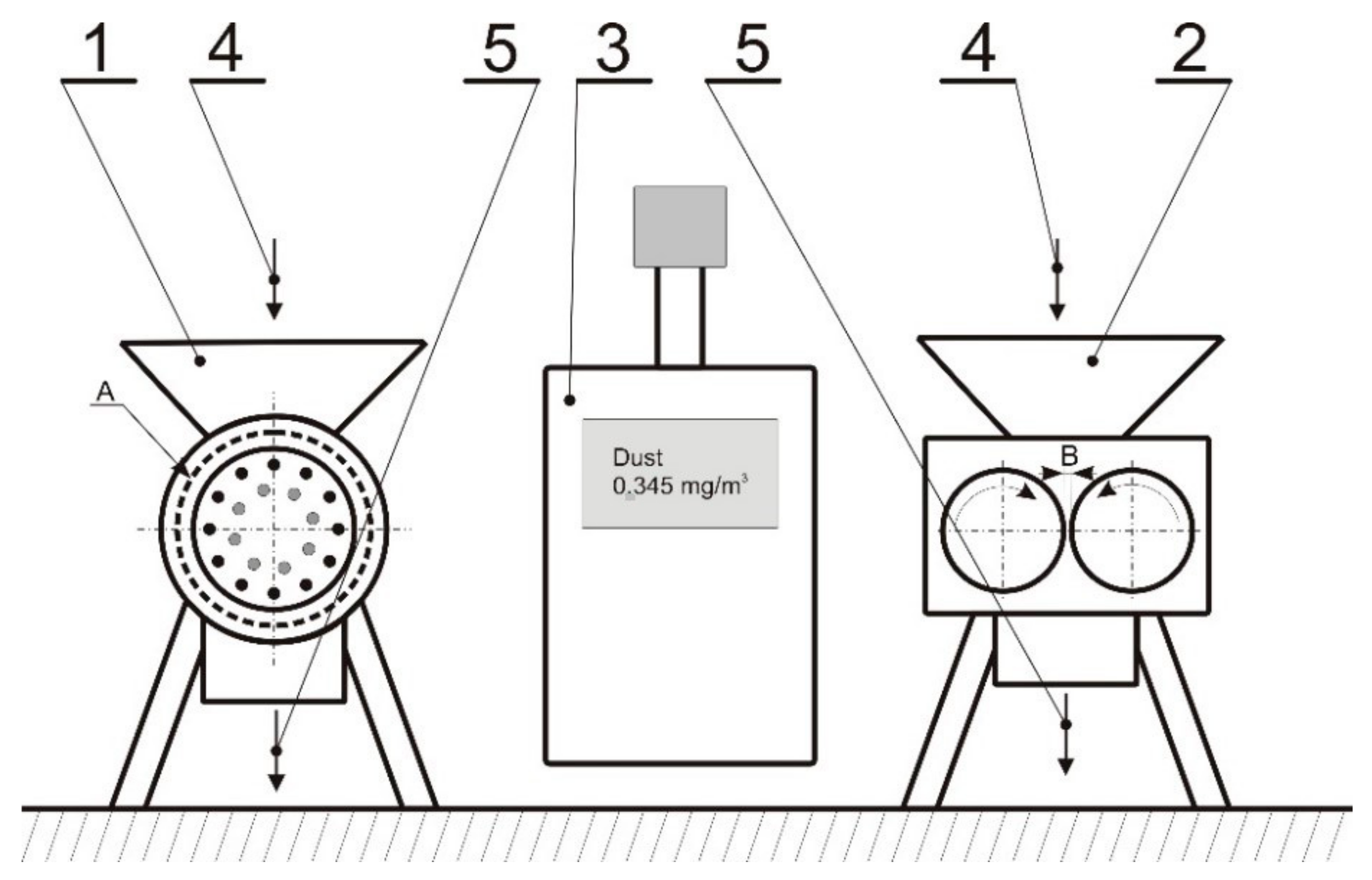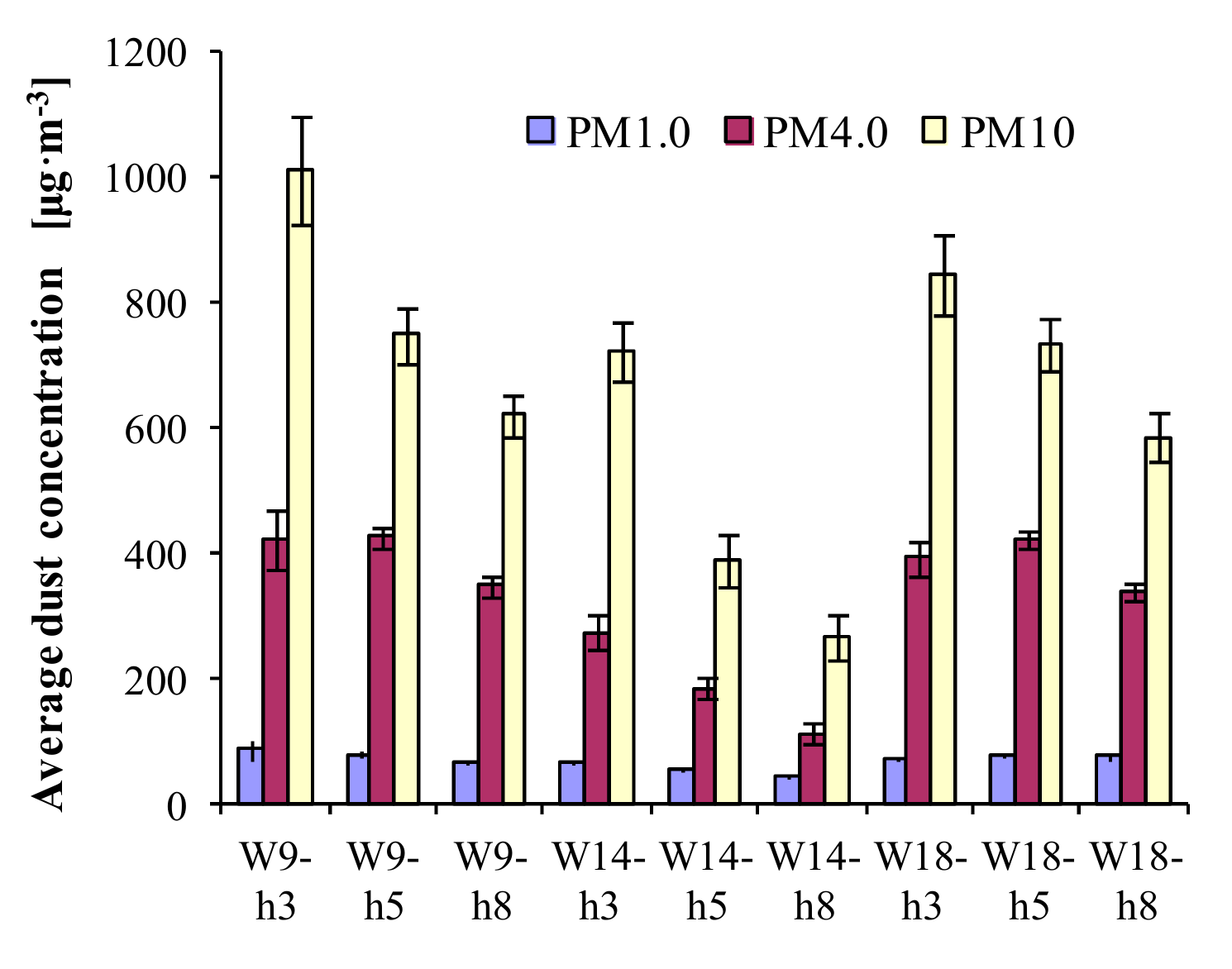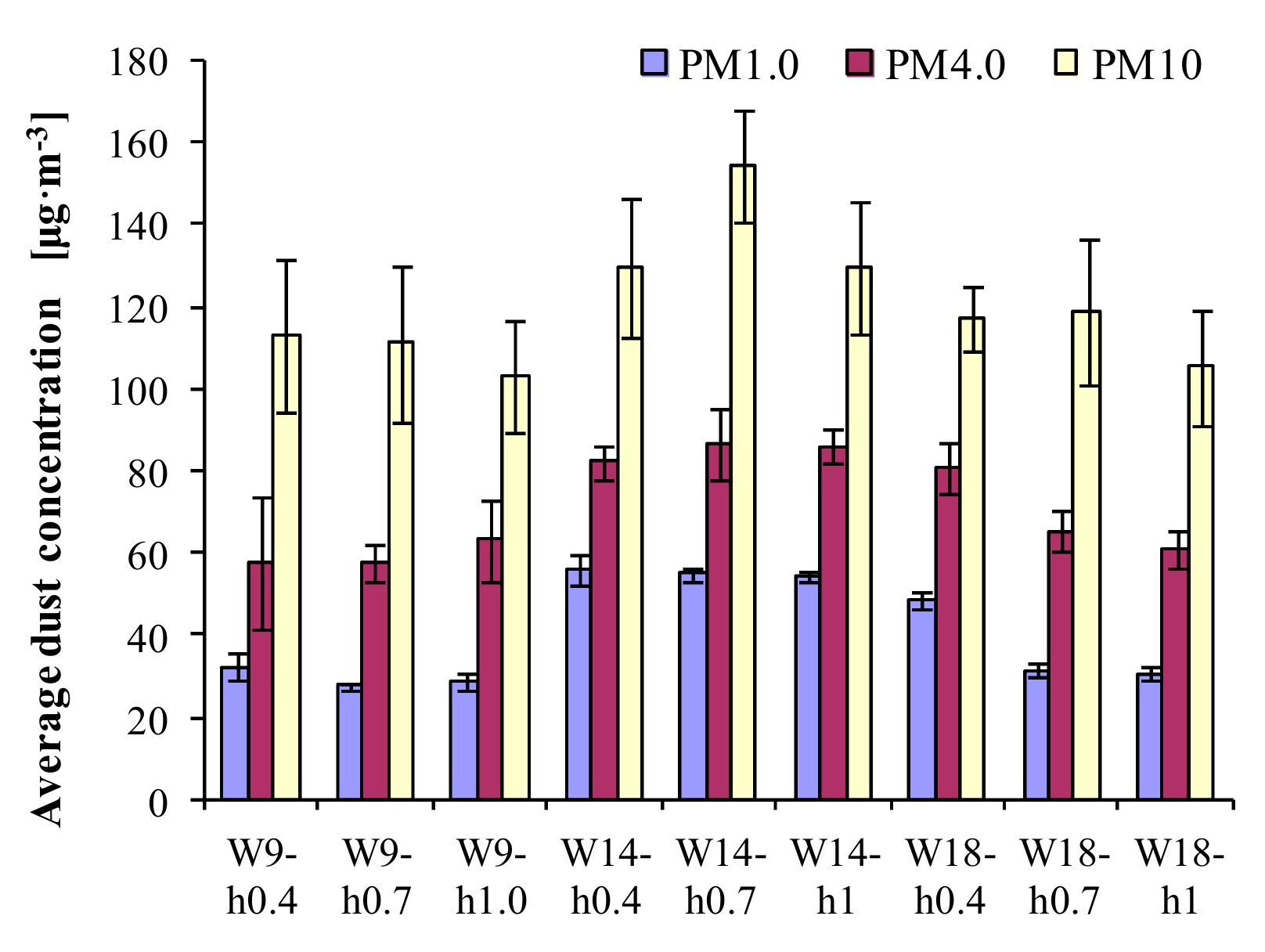Evaluation of Dust Concentration During Grinding Grain in Sustainable Agriculture
Abstract
:1. Introduction
2. Materials and Methods
- Mw—amount of water necessary for moistening,
- MN—moistened grain mass,
- X1—initial moisture content,
- X2—desired moisture content.
3. Results and Discussion
4. Conclusions
Author Contributions
Funding
Conflicts of Interest
References
- Amantea, R.P.; Fortes, M.; Ferreira, W.R.; Santos, G.T. Energy and exergy efficiencies as design criteria for grain dryers. Dry. Technol. 2018, 36, 491–507. [Google Scholar] [CrossRef]
- Lutfy, O.F.; Noor, S.B.M.; Abbas, K.A.; Marhaban, M.H. Some control strategies in agricultural grain driers: A review. J. Food Agric. Environ. 2008, 6, 74–85. [Google Scholar]
- Niedziółka, I.; Szpryngiel, M.; Kachel-Jakubowska, M.; Kraszkiewicz, A.; Zawiślak, K.; Sobczak, P.; Nadulski, R. Assessment of the energetic and mechanical properties of pellets produced from agricultural biomass. Renew. Energy 2015, 76, 312–317. [Google Scholar] [CrossRef]
- Kraszkiewicz, A.; Kachel-Jakubowska, M.; Niedziółka, I.; Zaklika, B.; Zawiślak, K.; Nadulski, R.; Sobczak, P.; Wojdalski, J.; Mruk, R. Impact of various kinds of straw and other raw materials on physical characteristics of pellets. Rocz. Ochr. Środowiska 2017, 19, 270–287. [Google Scholar]
- Zawiślak, K. Przetwarzanie Ziarna Kukurydzy na cele Paszowe. In Rozprawy Naukowe; Akademia Rolnicza w Lublinie: Lublin, Poland, 2006; pp. 1–95. Available online: http://yadda.icm.edu.pl/yadda/element/bwmeta1.element.agro-article-2e48e26a-bef0-41d8-b73f-ecd603e23ba6.
- Mahajan, S.P. Air Pollution Control Commonwealth of Learning; Ramachandra, T.V., Ed.; Capital Publishing Company: New Delhi, India, 2006. [Google Scholar]
- Kuskowska, K.; Dmochowski, D. Analiza rozkładu stężeń pyłu zawieszonego frakcji PM10, PM2.5 i PM1.0 na różnych wysokościach Mostu Gdańskiego. Zesz. Nauk. SGSP 2016, 53, 101–119. [Google Scholar]
- Frąk, M.; Majewski, G.; Zawistowska, K. Analysis of the quantity of microorganisms adsorbed on particulate matter PM10. Sci. Rev.–Eng. Environ. Sci. 2014, 64, 140–149. [Google Scholar]
- Warren, K.J.; Wyatt, T.A.; Romberger, D.J.; Ailts, I.; West, W.W.; Nelson, A.J.; Nordgren, T.M.; Staab, E.; Heires, A.J.; Poole, J.A. Post-Injury and Resolution Response to Repetitive Inhalation Exposure to Agricultural Organic Dust in Mice. Safety 2017, 3, 10. [Google Scholar] [CrossRef] [PubMed]
- Żukiewicz-Sobczak, W.; Cholewa, G.; Krasowska, E.; Chmielewska-Badora, J.; Zwoliński, J.; Sobczak, P. Grain dust originating from organic and conventional farming as a potential source of biological agents causing respiratory diseases in farmers. Postepy Dermatol. I Alergol. 2013, 6, 358–364. [Google Scholar] [CrossRef]
- Niculita-Hirzel, H.; Hantier, G.; Storti, F.; Plateel, G.; Roger, T. Frequent Occupational Exposure to Fusarium Mycotoxins of Workers in the Swiss Grain Industry. Toxins 2016, 8, 370. [Google Scholar] [CrossRef]
- European Environment Agency. EEA 2017. Air Quality of Europe; EEA: København, Denmark, 2017; ISSN 1977-8449. Available online: https://www.eea.europa.eu/publications/air-quality-in-europe-2017. (accessed on 26 February 2019).
- Klimat dla Polski – Polska dla klimatu: 1988-2018-2050. Available online: www.kobize.pl/pl/fileCategory/id/1/opracowania (accessed on 26 February 2019).
- WHO. WHO Air Quality Guidelines for Particulate Matter, Ozone, Nitrogen Dioxide and Sulfur Dioxide; Global Update 2005; WHO: Geneva, Switzerland, 2006; Available online: http://whqlibdoc.who.int/hq/2006/WHO_SDE_PHE_OEH_06.02_eng.pdf (accessed on 26 February 2019).
- Ashmore, M.R.; Dimitroulopoulou, C. Personal exposure of children to air pollution. Atmos. Environ. 2009, 43, 128–141. [Google Scholar] [CrossRef]
- Chen, C.; Zhao, B. Review of relationship between indoor and outdoor particles: I/O ratio, infiltration factor and penetration factor. Atmos. Environ. 2011, 45, 275–288. [Google Scholar] [CrossRef]
- Grahame, T.J.; Schlesinger, R.B. Evaluating the health risk from secondary sulfates in Eastern North American regional ambient air particulate matter. Toxicology 2005, 17, 15–27. [Google Scholar] [CrossRef] [PubMed]
- Pawłowski, L. How heavy metals affect sustainable development. Rocz. Ochr. Środowiska (Annu. Set Environ. Prot.) 2011, 13, 51–64. [Google Scholar]
- Zwoździak, A.; Sówka, I.; Fortuna, M.; Balińska-Miśkiewicz, W.; Willak-Janc, E.; Zwoździak, J. Wpływ stężeń pyłów (PM1, PM2.5, PM10) w środowisku wewnątrz szkoły na wartości wskaźników spirometrycznych u dzieci. Rocz. Ochr. Środowiska (Annu. Set Environ. Prot.) 2013, 15, 2022–2038. [Google Scholar]
- Żukiewicz-Sobczak, W.; Cholewa, G.; Krasowska, E.; Chmielewska-Badora, J.; Zwoliński, J.; Sobczak, P. Rye grains and the soil derived from under the organic and conventional rye crops as a potential source of biological agents causing respiratory diseases in farmers. Postępy Dermatol. I Alergol. 2013, 6, 373–380. [Google Scholar] [CrossRef] [PubMed]
- Dziki, D.; Laskowski, J. Study to analyze the influence of sprouting of the wheat grain on the grinding process. J. Food Eng. 2010, 96, 562–567. [Google Scholar] [CrossRef]
- Hameed Hassoon, W.; Dziki, D. The Study of Multistage Grinding of Rye. In Proceedings of the IX International Scientific Symposium; Farm Machinery and Processes Management in Sustainable Agriculture, Lublin, Poland, 22–24 November 2017. [Google Scholar] [CrossRef]
- Polski Komitet Normalizacyjny. PN-EN ISO 712:2009. Ziarno Zbóż i Przetwory Zbożowe. Oznaczanie Wilgotności; Polski Komitet Normalizacyjny: Warszawa, Poland, 2009. [Google Scholar]
- Shieh, J.Y.; Ku, C.H.; Christiani, D.C. Respiratory effects of the respirable dust (PM4.0). Epidemiology 2004, 15, 4–166. [Google Scholar] [CrossRef]
- De Lima Gondim, F.; Lima, Y.C.; Melo, P.O.; dos Santos, G.R.; Serra, D.S.; Araújo, R.S.; de Oliveira, M.L.M.; Lima, C.C.; Cavalcante, F.S.A. Exposure to PM4.0 from the combustion of cashew nuts shell in the respiratory system of mice previously exposed to cigarette smoke. Int. J. Recent Sci. Res. 2017, 8, 16762–16769. [Google Scholar] [CrossRef]
- Josino, J.B.; Serra, D.S.; Gomes, M.D.M.; Araújo, R.S.; de Oliveira, M.L.M.; Cavalcante, F.S.Á. Changes of respiratory system in mice exposed to PM4.0 or TSP from exhaust gases of combustion of cashew nut shell. Environ. Toxicol. Pharmacol. 2017, 56, 1–9. [Google Scholar] [CrossRef]
- Polski Komitet Normalizacyjny. PN-R-64798:2009. Pasze–Oznaczanie Rozdrobnienia; Polski Komitet Normalizacyjny: Warszawa, Poland, 2009. [Google Scholar]
- Dacarro, C.; Grisoli, P.; Del Frate, G.; Villani, S.; Grignani, E.; Cottica, D. Micro-organisms and dust exposure in an Italian grain mill. J. Appl. Microbiol. 2004, 98, 163–171. [Google Scholar] [CrossRef]
- Sobczak, P.; Zawiślak, K.; Żukiewicz-Sobczak, W.; Wróblewska, P.; Adamczuk, P.; Mazur, J.; Kozak, M. Organic dust in feed industry. Pol. J. Environ. Stud. 2015, 24, 5–2177. [Google Scholar] [CrossRef]
- Karpaciński, E.A. Exposure to inhalable flour dust in Canadian flour mills. Appl. Occup. Environ. Hyg. 2003, 18, 1022–1030. [Google Scholar] [CrossRef] [PubMed]
- Buczaj, A. Poziom zapylenia w wybranych zakładach przemysłu zbożowego w województwie lubelskim. Inżynieria Rol. 2011, 1, 7–13. [Google Scholar]
- Zawiślak, K.; Sobczak, P.; Kozak, M.; Mazur, J.; Panasiewicz, M.; Żukiewicz-Sobczak, W.; Wojdalski, J.; Mieszkalski, L. Microbiological analysis and concentration of organic dust in an herb processing plant. Pol. J. Environ. Study 2019, 28, 1–7. [Google Scholar] [CrossRef]
- Directive 2008/50/EC of the European Parliament and of the Council of 21 May 2008 on ambient air quality and cleaner air for Europe OJ L. Off. J. Eur. Union 2008, 152, 1–44.



| Designation | Description | Designation | Description |
|---|---|---|---|
| W9-h3 | Grain moisture content of 9%, the diameter of openings in the screen of the mill equal to 3 mm | W9-h0.4 | Grain moisture content of 9%, the working gap between rollers of the mill equal to 0.4 mm |
| W9-h5 | Grain moisture content of 9%, the diameter of openings in the screen of the mill equal to 5 mm | W9-h0.7 | Grain moisture content of 9%, the working gap between rollers of the mill equal to 0.7 mm |
| W9-h8 | Grain moisture content of 9%, the diameter of openings in the screen of the mill equal to 8 mm | W9-h1 | Grain moisture content of 9%, the working gap between rollers of the mill equal to 1 mm |
| W14-h3 | Grain moisture content of 14%, the diameter of openings in the screen of the mill equal to 3 mm | W14-h0.4 | Grain moisture content of 14%, the working gap between rollers of the mill equal to 0.4 mm |
| W14-h5 | Grain moisture content of 14%, the diameter of openings in the screen of the mill equal to 5 mm | W14-h0.7 | Grain moisture content of 14%, the working gap between rollers of the mill equal to 0.7 mm |
| W14-h8 | Grain moisture content of 14%, the diameter of openings in the screen of the mill equal to 8 mm | W14-h1 | Grain moisture content of 14%, the working gap between rollers of the mill equal to 1 mm |
| W18-h3 | Grain moisture content of 18%, the diameter of openings in the screen of the mill equal to 3 mm | W18-h0.4 | Grain moisture content of 18%, the working gap between rollers of the mill equal to 0.4 mm |
| W18-h5 | Grain moisture content of 18%, the diameter of openings in the screen of the mill equal to 5 mm | W18-h0.7 | Grain moisture content of 18%, the working gap between rollers of the mill equal to 0.7 mm |
| W18-h8 | Grain moisture content of 18%, the diameter of openings in the screen of the mill equal to 8 mm | W18-h1 | Grain moisture content of 18%, the working gap between rollers of the mill equal to 1 mm |
| Mill | Moisture Content of the Raw Material [%] | Screen [mm] | Max. [μg·m−3] | Min. [μg·m−3] | Dusts Average [μg·m−3] | Dusts—S.D. | Homogeneous Group |
|---|---|---|---|---|---|---|---|
| Hammer mill | - | Control | 50 | 33 | 38.7 | 4.4 | |
| 9 | 3 | 121 | 69 | 84 | 14.3 | ||
| 5 | 82 | 69 | 77.5 | 3.7 | d | ||
| 8 | 77 | 59 | 65.3 | 4 | c | ||
| 14 | 3 | 71 | 57 | 63.6 | 4.4 | c | |
| 5 | 66 | 51 | 55.9 | 2.9 | b | ||
| 8 | 49 | 39 | 42.2 | 2 | b | ||
| 18 | 3 | 77 | 63 | 69.4 | 3.6 | ||
| 5 | 83 | 72 | 77.7 | 2.6 | d | ||
| 8 | 92 | 66 | 74 | 5.5 | d | ||
| Roller mill | - | Control | 39 | 25 | 27.1 | 3 | a |
| 9 | 0.4 | 39 | 28 | 32.3 | 3.2 | ||
| 0.7 | 29 | 26 | 27.7 | 0.9 | a | ||
| 1 | 36 | 26 | 28.6 | 2 | a | ||
| 14 | 0.4 | 68 | 51 | 56.2 | 3.8 | ||
| 0.7 | 58 | 52 | 54.9 | 1.6 | b | ||
| 1 | 56 | 52 | 54.2 | 1 | b | ||
| 18 | 0.4 | 52 | 43 | 48.6 | 1.9 | ||
| 0.7 | 38 | 29 | 31.6 | 1.9 | |||
| 1 | 34 | 28 | 30.7 | 1.6 | a |
| Mill | Moisture Content of the Raw Material [%] | Screen [mm] | Max. [μg·m−3] | Min. [μg·m−3] | Dusts Average [μg·m−3] | Dusts—S.D. | Homogeneous Group |
|---|---|---|---|---|---|---|---|
| Hammer mill | - | Control | 140 | 106 | 120.4 | 7.5 | b |
| 9 | 3 | 530 | 344 | 421.6 | 46.9 | d | |
| 5 | 463 | 404 | 423.6 | 15.5 | d | ||
| 8 | 375 | 307 | 345.8 | 17.1 | c | ||
| 14 | 3 | 354 | 234 | 272.2 | 26.7 | ||
| 5 | 213 | 156 | 183.1 | 15.6 | |||
| 8 | 131 | 81 | 110.7 | 15 | b | ||
| 18 | 3 | 445 | 342 | 391.5 | 28.9 | ||
| 5 | 451 | 391 | 421 | 15 | d | ||
| 8 | 359 | 296 | 335 | 13.6 | c | ||
| Roller mill | - | Control | 55 | 37 | 41.9 | 3.7 | |
| 9 | 0.4 | 105 | 42 | 57.7 | 15.8 | ||
| 0.7 | 65 | 49 | 57.6 | 4.5 | |||
| 1 | 84 | 48 | 63.1 | 9.5 | a | ||
| 14 | 0.4 | 90 | 75 | 82.3 | 4.1 | ||
| 0.7 | 104 | 74 | 86.8 | 8.7 | |||
| 1 | 94 | 78 | 86.2 | 3.9 | |||
| 18 | 0.4 | 94 | 68 | 81 | 6.1 | ||
| 0.7 | 75 | 56 | 65.4 | 5 | |||
| 1 | 69 | 53 | 61.3 | 4.6 | a |
| Mill | Moisture Content of the Raw Material [%] | Screen [mm] | Max. [mg·m−3] | Min. [mg·m−3] | Dusts Average [mg·m−3] | Dusts—S.D. | Homogeneous Group |
|---|---|---|---|---|---|---|---|
| Hammer mill | - | Control | 294 | 158 | 200.3 | 30.4 | |
| 9 | 3 | 1200 | 832 | 1011.9 | 87.7 | ||
| 5 | 837 | 670 | 746.6 | 43.8 | c | ||
| 8 | 698 | 552 | 620.3 | 32.9 | |||
| 14 | 3 | 795 | 647 | 720.9 | 48.1 | c | |
| 5 | 460 | 297 | 387.2 | 40 | |||
| 8 | 314 | 184 | 262.8 | 35.7 | |||
| 18 | 3 | 1020 | 702 | 842.3 | 63.5 | ||
| 5 | 811 | 637 | 730.9 | 41 | c | ||
| 8 | 667 | 525 | 583.2 | 39.4 | |||
| Roller mill | - | Control | 86 | 54 | 68.8 | 8.8 | a |
| 9 | 0.4 | 160 | 78 | 113.1 | 18.7 | ||
| 0.7 | 157 | 80 | 111 | 18.7 | |||
| 1 | 150 | 90 | 102.8 | 13.6 | a,b | ||
| 14 | 0.4 | 165 | 106 | 129.3 | 16.9 | b | |
| 0.7 | 178 | 134 | 154.5 | 13.5 | |||
| 1 | 161 | 100 | 129.6 | 16.1 | |||
| 18 | 0.4 | 129 | 104 | 117.4 | 8 | ||
| 0.7 | 144 | 86 | 119 | 18 | |||
| 1 | 128 | 72 | 105.3 | 14 | b |
| Hammer mill | W9-h3 | W9-h5 | W9-h8 | W14-h3 | W14-h5 | W14-h8 | W18-h3 | W18-h5 | W18-h8 |
|---|---|---|---|---|---|---|---|---|---|
| The share particles smaller than 0.1 mm [%] | 3.98 | 1.08 | 0.6 | 1.99 | 0.51 | 0.31 | 1.78 | 0.34 | 0.06 |
| The average size of particles [mm] | 0.563 | 0.975 | 1.094 | 0.651 | 1.067 | 1.309 | 0.609 | 1.106 | 1.693 |
| Roller mill | W9-h0.4 | W9-h0.7 | W9-h1 | W14-h0.4 | W14-h0.7 | W14-h1 | W18-h0.4 | W18-h0.7 | W18-h1 |
| The share particles smaller than 0.1 mm [%] | 2.78 | 1.57 | 1.7 | 1.26 | 0.46 | 0.24 | 0.38 | 0.22 | 0.14 |
| The average size of particles [mm] | 1.003 | 1.334 | 1.942 | 1.928 | 2.521 | 2.877 | 2.775 | 2.955 | 2.997 |
© 2019 by the authors. Licensee MDPI, Basel, Switzerland. This article is an open access article distributed under the terms and conditions of the Creative Commons Attribution (CC BY) license (http://creativecommons.org/licenses/by/4.0/).
Share and Cite
Sobczak, P.; Mazur, J.; Zawiślak, K.; Panasiewicz, M.; Żukiewicz-Sobczak, W.; Królczyk, J.; Lechowski, J. Evaluation of Dust Concentration During Grinding Grain in Sustainable Agriculture. Sustainability 2019, 11, 4572. https://doi.org/10.3390/su11174572
Sobczak P, Mazur J, Zawiślak K, Panasiewicz M, Żukiewicz-Sobczak W, Królczyk J, Lechowski J. Evaluation of Dust Concentration During Grinding Grain in Sustainable Agriculture. Sustainability. 2019; 11(17):4572. https://doi.org/10.3390/su11174572
Chicago/Turabian StyleSobczak, Paweł, Jacek Mazur, Kazimierz Zawiślak, Marian Panasiewicz, Wioletta Żukiewicz-Sobczak, Jolanta Królczyk, and Jerzy Lechowski. 2019. "Evaluation of Dust Concentration During Grinding Grain in Sustainable Agriculture" Sustainability 11, no. 17: 4572. https://doi.org/10.3390/su11174572





